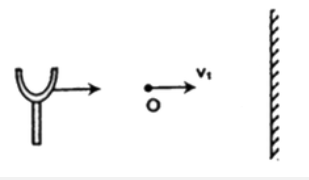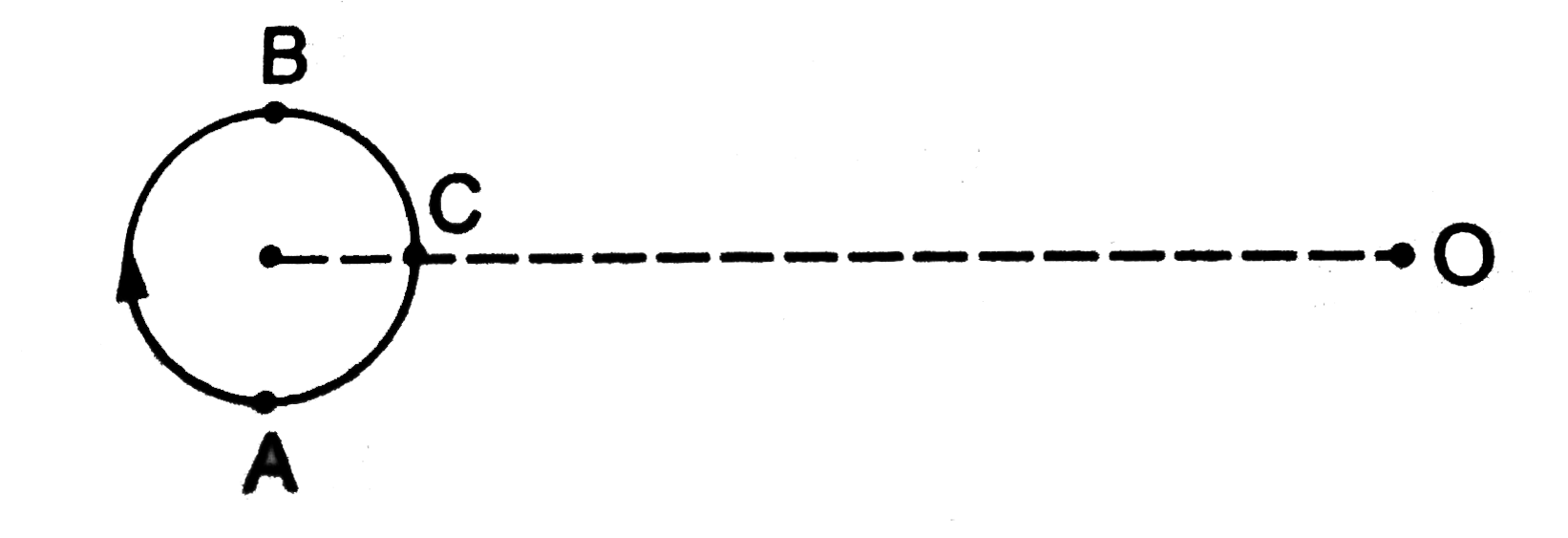Two sound sources are moving away from a stationary observer in opposite direction with velocities V1 and V2(V1>V2). The frequency of both the sources is 900 Hz. V1 and V2 are both quite less than speed of sound, V=300ms. Find the value of (V1−V2) so that beat frequency observed by observer is 9 Hz. (in m/s).
To solve the problem, we need to find the value of (V1−V2) such that the beat frequency observed by a stationary observer is 9 Hz. We will follow these steps:
Step 1: Understand the Beat Frequency Concept
The beat frequency is the difference between the frequencies of two sound sources. If one source has a frequency f1 and the other has a frequency f2, then the beat frequency fb is given by:
fb=|f1−f2|
In this case, we want fb=9Hz.
Step 2: Calculate the Frequencies of the Moving Sources
Given that both sources are moving away from the observer, we can use the Doppler effect formula for the frequency observed:
f′=fVV+Vs
where:
- f′ is the observed frequency,
- f is the source frequency (900 Hz),
- V is the speed of sound (300 m/s),
- Vs is the speed of the source.
For the first source moving with speed V1:
f1=900300300+V1
For the second source moving with speed V2:
f2=900300300+V2
Step 3: Set Up the Equation for Beat Frequency
Now, we can express the beat frequency as:
|f1−f2|=9
Substituting the expressions for f1 and f2:
∣∣∣900300300+V1−900300300+V2∣∣∣=9
Step 4: Simplify the Equation
Factoring out the common terms:
900∣∣∣300300+V1−300300+V2∣∣∣=9
Dividing both sides by 900:
∣∣∣300300+V1−300300+V2∣∣∣=9900=0.01
Step 5: Solve the Absolute Value Equation
Let’s solve the equation:
300(300+V2)−300(300+V1)(300+V1)(300+V2)=0.01
This simplifies to:
300(V2−V1)(300+V1)(300+V2)=0.01
Cross-multiplying gives:
300(V2−V1)=0.01(300+V1)(300+V2)
Step 6: Substitute V1−V2
Since V1>V2, we can write:
V1−V2=3m/s
Final Answer
Thus, the value of (V1−V2) is:
3m/s
The beat frequency is the difference between the frequencies of two sound sources. If one source has a frequency f1 and the other has a frequency f2, then the beat frequency fb is given by:
fb=|f1−f2|
In this case, we want fb=9Hz.
Given that both sources are moving away from the observer, we can use the Doppler effect formula for the frequency observed:
f′=fVV+Vs
where:
- f′ is the observed frequency,
- f is the source frequency (900 Hz),
- V is the speed of sound (300 m/s),
- Vs is the speed of the source.
f1=900300300+V1
f2=900300300+V2
Now, we can express the beat frequency as:
|f1−f2|=9
Substituting the expressions for f1 and f2:
∣∣∣900300300+V1−900300300+V2∣∣∣=9
Factoring out the common terms:
900∣∣∣300300+V1−300300+V2∣∣∣=9
Dividing both sides by 900:
∣∣∣300300+V1−300300+V2∣∣∣=9900=0.01
Let’s solve the equation:
300(300+V2)−300(300+V1)(300+V1)(300+V2)=0.01
This simplifies to:
300(V2−V1)(300+V1)(300+V2)=0.01
Cross-multiplying gives:
300(V2−V1)=0.01(300+V1)(300+V2)
Since V1>V2, we can write:
V1−V2=3m/s
Thus, the value of (V1−V2) is:
3m/s
Topper's Solved these Questions
- SOUND WAVES AND DOPPLER EFFECTBOOK - CENGAGE PHYSICS ENGLISHCHAPTER - SOUND WAVES AND DOPPLER EFFECTEXERCISE - Comprehension
144 Videos
- RIGID BODY DYNAMICS 2BOOK - CENGAGE PHYSICS ENGLISHCHAPTER - RIGID BODY DYNAMICS 2EXERCISE - Interger
2 Videos
- SUPERPOSITION AND STANDING WAVESBOOK - CENGAGE PHYSICS ENGLISHCHAPTER - SUPERPOSITION AND STANDING WAVESEXERCISE - Comprehension Type
5 Videos
Similar Questions
Two sources of sound are moving in opposite directions with velocities V1 and V2(V1>V2). Both are moving away from a stationary observer. The frequency of both the source is 1700Hz. What is the value of (V1−V2) so that the beat frequency observed by the observer is 10Hz. Vsound=340m/s and assume that V1 and V2 both are very much less than Vsound.
View SolutionTwo sound sources are moving in opposite directions with velocities v1andv2(v1>v2) . Both are moving away from a stationary observer. The frequency of both the sources is 900 Hz. What is the value of v1−v2 so that the beat frequency aboserved by the observer is 6 Hz. speed of sound v= 300 m/s given ,that v1andv2<<v
View SolutionA stationary particle explodes into two particle of a masses m1andm2 which move in opposite direction with velocities v1andv2. The ratio of their kinetic energies E1/E2 is
View SolutionThere is a source of sound (a tuning fork) moving towards a reflecting wall will a speed of 30ms−1. The velocity of the sound in air is 330ms−1and the frequency of the tuning fork is 600 Hz. The observer is between the source and the wall and is moving with some velocity V1 towards the wall. The beat frequency heard by the observer is 4 Hz. If the tuning fork is waxed, the frequency beats heard by the observer becomes 3 Hz. If the new frequency of tuning fork is k then k/50 is

View SolutionA small source of sound moves on a circle as shown in figure and an observer is sitting at O. Let v1,v2,v3 be the frequencies heard when the source is at A,B and C respectively.
 .
.
View SolutionWhen a source of frequency f0 moves away from a stationary observer with a certain velocity, an apparent frequency f' is observed. When it moves with the same speed towards the observer, the observed frequecy is 1.2f'. If the velocity of sound is v, then the acutual frequency f0 is
View SolutionA sound source is moving with speed 50m/s towards a fixed observer. Frequency observed by observer is 1000Hz. Find out apparent frequency observed by observer when source is moving away from observer (Speed of sound =350m/s)
View SolutionA sound source is moving with speed 50m/s towards a fixed observer. Frequency observed by observer is 1000Hz. Find out apparent frequency observed by observer when source is moving away from observer (Speed of sound =350m/s)
View SolutionA source of sound is travelling towards a stationary observer. The frequency of sound heard by the observer is 25% more that the actual frequency. If the speed of sound is v, that of the source is
View SolutionTwo sources of sound S1 and s2 are moving towards and away from a stationery observer with same speed respectively . Observer detects 3 beats per second. Find speed of sources (approximately) .
Given, F1=F2=500 Hz, speed of air = 330 m/s

View Solution
